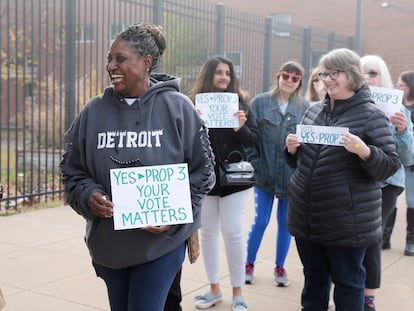Gerrymandering in the US: When politicians choose their voters, not the other way around
The Texas county of Fort Bend, the most diverse in the United States, is one of the most extreme examples of how this process can silence minority candidates


The newly created TX-22 electoral district, which borders Houston on the west and south, exists only in the minds of the Republican lawmakers who drew it. It results from mixing almost all of Fort Bend County, a diverse and dynamic place, with two others with a white majority and a tenth of the population: Wharton and Matagorda. The imaginary demarcation, which includes a piece of Brazoria to the east, looks a bit like a revolver without a barrel.
But what the Republicans behind the design have taken away is something else: the power of the minorities who have made Fort Bend the most ethnically diverse community in the country. The county’s population is roughly evenly divided into four groups: white (which was 70% just three decades ago), Black, Asian and Latino. With the new map, the electoral district paints a very different picture: white people (who usually vote Republican in Texas) are the majority, with 54%, 23% are Hispanics, 11% are African Americans and 10% Asian. This configuration means it will be almost impossible for any member of the last three groups to be elected to the House of Representatives in the next 10 years, when the map may be redrawn. The first consequences of the new electoral district will be seen at the midterm elections on Tuesday. Everything indicates that the Republican former sheriff Troy Nehls, author of a book which falsely argues that the 2020 elections were stolen from Donald Trump, will be reelected to the House.
TX-22 is one of the most extreme examples of gerrymandering, an undemocratic and very American practice that has been perfected in Texas over the years. The practice stems from noble intentions. Every 10 years the US census is updated, and when that happens, the 435 seats in the federal Congress are redistributed. States that have grown in population are given more seats, and vice versa. In the 2020 census, six states lost one of their seats, and another five increased their representation. The only one that received two extra seats was Texas (up to 38), which gained four million residents in the past 10 years. Within Texas, there has been especially strong population growth in Fort Bend, which has attracted residents with its job opportunities, mild weather, high-quality schools and hospitals, relatively low cost of land and seemingly endless space to build (thanks to real estate deregulation).

A total of 95% of those new Texans belong to a racial minority, but the new map pulls together three districts where white people are the majority. “It is the perpetuation of an unjust system at the expense of the communities that are in fact driving the economic and population growth of the state,” says Yurij Rudensky, an attorney with the nonpartisan Brennan Center for Justice.
Electoral maps are drawn at all levels of government: national, state, regional and local. In some states, such as California and Michigan, an independent commission is in charge of the process, but in most cases, it is up to the political party that is in control of the state assembly or county. This group typically demarks the electoral district to favor their interests. In the case of Texas, Republicans have governed the state for the past two decades, in part because it is has used gerrymandering to stay in power. Democrats have also shown a strong fondness for gerrymandering in places such as New York, where their latest electoral maps were challenged in court.
“This perverse practice allows politicians to choose their voters, not the other way around,” Jamie Raskin, a prominent Democratic lawmaker in the House, told EL PAÍS. This is not the only perverse effect of the practice: gerrymandering also silences the voice of millions of Americans and discourages them from becoming politically involved as they do not recognize themselves in their representatives. It also fuels extremism. When there is no competition, there is also no need to make compromises to seek consensus.
After its redesign, the map of Texas has been divided into districts that meet quantitative standards, but either take on impossible shapes, such as District 15, which is a long corridor of land from north to south, or split communities in half. This is the case in Denton, near Dallas, which has been divided in two.
In Fort Bend, in addition to frustrating the aspirations of minorities, the new electoral map has also crippled the options of the Democratic Party. Child psychologist Jennifer Cantú, who protests against gerrymandering in her spare time, showed EL PAÍS how the redesign has favored the Republicans. At a taco shop in Rosenberg, one of the county’s urban centers, she used an app to demonstrate the difference. With the last TX-22 map drawn in 2010, Donald Trump won 49.7% of the vote in 2020, compared to 48.8% for Joe Biden. With the new one, the margin would have been 57.3% versus 41.2%.
“In 2018 [Republicans] saw that we had some big wins. They thought it was a fluke. Two years later they realized it wasn’t, and then they used all these voter suppression tactics,” said Cynthia Ginyard, Fort Bend Democratic Party Chair.
Mary Charles, a Latina supporter of the Republican Party, whose local organization did not respond to a request for comment, explained outside a polling station that “both parties are guilty [of gerrymandering],” and that the Democrats shouldn’t blame potential losses on the practice. “They will lose the election, but not because of that, but because of the [Joe] Biden disaster.”
Ginyard, for her part, admitted that “in the highly unlikely event” that her party wins the election, she would also gerrymander. “Although we would do it more humanely. Those guys are ruthless,” she said.
What upsets Cantú the most is that “Fort Bend has a big enough population to constitute an electoral district.” The law on redrawing electoral maps requires that the design be non-discriminatory, geographically compact, walkable and respectful of “communities of interest.” “The latter is almost never fulfilled,” said the activist, who considers that gerrymandering “goes beyond the political game.” “It affects people’s lives. It influences things like whether the streetlights on your street work or how far the hospital is from your house. If your representatives take you for granted, they won’t bother to keep you happy. They will be able to spend their time sucking their thumb without jeopardizing their position.”

After lunch, Cantú drove her car to the parking lot of a polling station to show the effects of gerrymandering in real time. She was looking for two of the few minority candidates that are running for election on November 8. Juli Matthew, who became the first Indian American woman to be elected to the bench in the US in 2018, is running to be reelected in Fort Bend County. She is confident in her chances, arguing that “many Republicans will change their vote due to the [Supreme Court] ruling on abortion,” which overturned Roe vs. Wade and ended the constitutional right to abortion. Stephen Longoria, meanwhile, is the only Latino running for the Democratic Party. Like Matthew, he is running to be appointed judge. Running for the House is Eugene Howard, president of the local branch of the National Association for the Advancement of Colored People (NAACP), a century-old organization that defends the Black community. He believes that “white people want to turn Fort Bend into South Africa 2.0; a place where the 40% dominate the 60%.” “They are worried that when we are the majority, we may plan to do with them what they did with us,” he added.
The truth is that gerrymandering, which is almost as old as the American experiment itself, was around long before diversity arrived. The practice is named after Elbridge Gerry (1744-1814), the fifth vice president of the United States. To favor a friend, he drew a salamander-shaped district, which is where the “mander” in gerrymandering comes from. “Studying the phenomenon, I came to the conclusion that the Greeks had already used it,” Lydia Ozuna, 74, said Thursday at her home in a suburb of Katy, at the north end of TX-22. In 2017, she founded Texans Against Gerrymandering, which fights against the effects of partisan design. “In the state, we have a long history of discrimination against Hispanics. When I was little, we were segregated,” she recalled. “And now these maps take away our voice again. My dad used to say that it doesn’t matter what party the politicians are from: the result is always going to be the same for us. And recently I heard a young activist say that, when asked if Latinos are Democrats or Republicans, she always answers: ‘Not one thing nor the other: what they are is poor.’ When you have to work two or three jobs to get by, it is difficult to get politically involved.”
Ozuna had prepared a dossier that tells the story of Texas from the 1990s to the present through gerrymandering. It is a story that repeats itself: every time the decade changes, new electoral maps are drawn and the lawsuits rain down. “The work of an organization like ours really starts now,” she said.
The new TX-22 electoral map is no exception; it is also facing nearly a dozen lawsuits. But it is too late for changes to be made before Tuesday’s midterm election. “The sentence may take one or two years, or it may not be resolved by the time the next census arrives, it’s crazy,” explained lawyer Deborah Chen, one of the 27 plaintiffs of the lawsuit.
Chen is a member of the Asian Americans and Pacific Islander (AAPI) community. She met EL PAÍS in an office in Chinatown, south of Houston. “In Fort Bend, we represent a little more than 20% of the population, but they have erased us. In the 2020 elections, we entertained the possibility of sending one of our own to Washington [Sri Kulkarni, of Indian origin, who lost by seven points to Nehls]. Everything indicated that would he would overtake [Republican candidate Troy Nehls], but this chance has been completely eliminated after the redistricting.” The Republicans have used two of the most common gerrymandering tricks to achieve this: cracking i.e. breaking minority voters off from the district they were in, and packing i.e. reassigning them to Democratic districts that are already considered lost.
Beyond lawsuits, the other way to address the problem is to leave the work of drawing electoral maps to independent commissions. “That is the goal, to ensure that it does not depend on people whose livelihood is compromised by how the drawing is made,” said Ozuna.
Congressman Raskin, for his part, pointed out that in 2019, the Democrats introduced H.R. 1, a bill known as “The For the People Act,” which prohibits gerrymandering. It has been passed twice in Congress, but both times it was blocked by Republicans in the Senate.
At Tuesday’s midterm election, the entire House of Representatives and a third of the Senate are up for grabs. Polls indicate that the Democrats will lose control of the House, and Californian Congressman Kevin McCarthy will replace Nancy Pelosi as House speaker. McCarthy has been a harsh critic of Democratic gerrymandering in New York, but no one expects him to give H.R. 1 another chance.
Tu suscripción se está usando en otro dispositivo
¿Quieres añadir otro usuario a tu suscripción?
Si continúas leyendo en este dispositivo, no se podrá leer en el otro.
FlechaTu suscripción se está usando en otro dispositivo y solo puedes acceder a EL PAÍS desde un dispositivo a la vez.
Si quieres compartir tu cuenta, cambia tu suscripción a la modalidad Premium, así podrás añadir otro usuario. Cada uno accederá con su propia cuenta de email, lo que os permitirá personalizar vuestra experiencia en EL PAÍS.
¿Tienes una suscripción de empresa? Accede aquí para contratar más cuentas.
En el caso de no saber quién está usando tu cuenta, te recomendamos cambiar tu contraseña aquí.
Si decides continuar compartiendo tu cuenta, este mensaje se mostrará en tu dispositivo y en el de la otra persona que está usando tu cuenta de forma indefinida, afectando a tu experiencia de lectura. Puedes consultar aquí los términos y condiciones de la suscripción digital.
More information
Archived In
Últimas noticias
Welcome to the post-religion era: The idea of Christianity as the absolute truth has become obsolete
‘I thought you would like it’: The risky sexual practice popularized by TV shows and TikTok
The digitalization of tourism: ‘They promise experiences and gave us the worst possible one’
Mexican peso defies uncertainty with forecasts of a new period of stability in 2026
Most viewed
- Sinaloa Cartel war is taking its toll on Los Chapitos
- Reinhard Genzel, Nobel laureate in physics: ‘One-minute videos will never give you the truth’
- Oona Chaplin: ‘I told James Cameron that I was living in a treehouse and starting a permaculture project with a friend’
- Why the price of coffee has skyrocketed: from Brazilian plantations to specialty coffee houses
- Silver prices are going crazy: This is what’s fueling the rally










































